engine TOYOTA YARIS CROSS 2023 Owners Manual
[x] Cancel search | Manufacturer: TOYOTA, Model Year: 2023, Model line: YARIS CROSS, Model: TOYOTA YARIS CROSS 2023Pages: 698, PDF Size: 147.65 MB
Page 6 of 698

4
Owners Manual_Europe_M52N75_en
TABLE OF CONTENTS
5-1. Using the air conditioning
system and defogger
Automatic air conditioning sys-
tem .................................... 342
Heated steering wheel/seat
heaters.............................. 348
5-2. Using the interior lights
Interior lights list .................. 350
5-3. Using the storage features
List of storage features ....... 352
Luggage compartment features
.......................................... 355
5-4. Other interior features
Other interior features ......... 359
6-1. Maintenance and care
Cleaning and protecting the
vehicle exterior ................. 368
Cleaning and protecting the
vehicle interior .................. 371
6-2. Maintenance
Maintenance requirements . 376
6-3. Do-it-yourself maintenance
Do-it-yourself service precau-
tions .................................. 378
Hood ................................... 380
Positioning a floor jack ........ 381
Engine compartment........... 383
12-volt battery ..................... 388
Tires .................................... 390
Tire inflation pressure ......... 400
Wheels ................................ 402
Air conditioning filter ........... 404
Cleaning the hybrid battery (trac-
tion battery) air intake vent and
filter ................................... 406
Wireless remote control/elec-
tronic key battery .............. 409
Checking and replacing fuses
.......................................... 413
Light bulbs .......................... 417
7-1. Essential information
Emergency flashers ............ 426
If your vehicle has to be stopped
in an emergency ............... 426
If the vehicle is submerged or
water on the road is rising 427
5Interior features
6Maintenance and care
7When trouble arises
Page 9 of 698

7
Owners Manual_Europe_M52N75_en
authorized repairer, or any reliable
repairer for precautionary mea-
sures or special instructions regard-
ing installation of an RF-transmitter
system.
Further information regarding fre-
quency bands, power levels,
antenna positions and installation
provisions for the installation of RF-
transmitters, is available on request
at any authorized Toyota retailer or
Toyota authorized repairer, or any
reliable repairer.
High voltage parts and cables on
the hybrid electric vehicles emit
approximately the same amount of
electromagnetic waves as the con-
ventional gasoline powered vehi-
cles or home electronic appliances
despite of their electromagnetic
shielding.
Unwanted noise may occur in the
reception of the radio frequency
transmitter (RF-transmitter).
The vehicle is equipped with
sophisticated computers that will
record certain data, such as:
• Engine speed/Electric motor
speed (traction motor speed)
• Accelerator status
• Brake status
• Vehicle speed
• Operation status of the driving
assist systems
• Images from the cameras
Your vehicle is equipped with cameras.
Contact any authorized Toyota retailer
or Toyota authorized repairer, or any
reliable repairer for the location of
recording cameras.
The recorded data varies according
to the vehicle grade level, options
and destinations with which it is
equipped.
These computers do not record
conversations or sounds, and only
record images outside of the vehi-
cle in certain situations.
Data usage
Toyota may use the data recorded in
this computer to diagnose malfunc-
tions, conduct research and develop-
ment, and improve quality.
Toyota will not disclose the recorded
data to a third party except:
• With the consent of the vehicle owner
or with the consent of the lessee if
the vehicle is leased
• In response to an official request by
the police, a court of law or a govern-
ment agency
• For use by Toyota in a lawsuit
• For research purposes where the
data is not tied to a specific vehicle or
vehicle owner
Recorded image information can
be erased by any authorized
Toyota retailer or Toyota autho-
rized repairer, or any reliable
repairer.
The image recording function can be
disabled. However, if the function is dis-
abled, data from when the system oper-
ates will not be available.
Vehicle data recording
Page 15 of 698
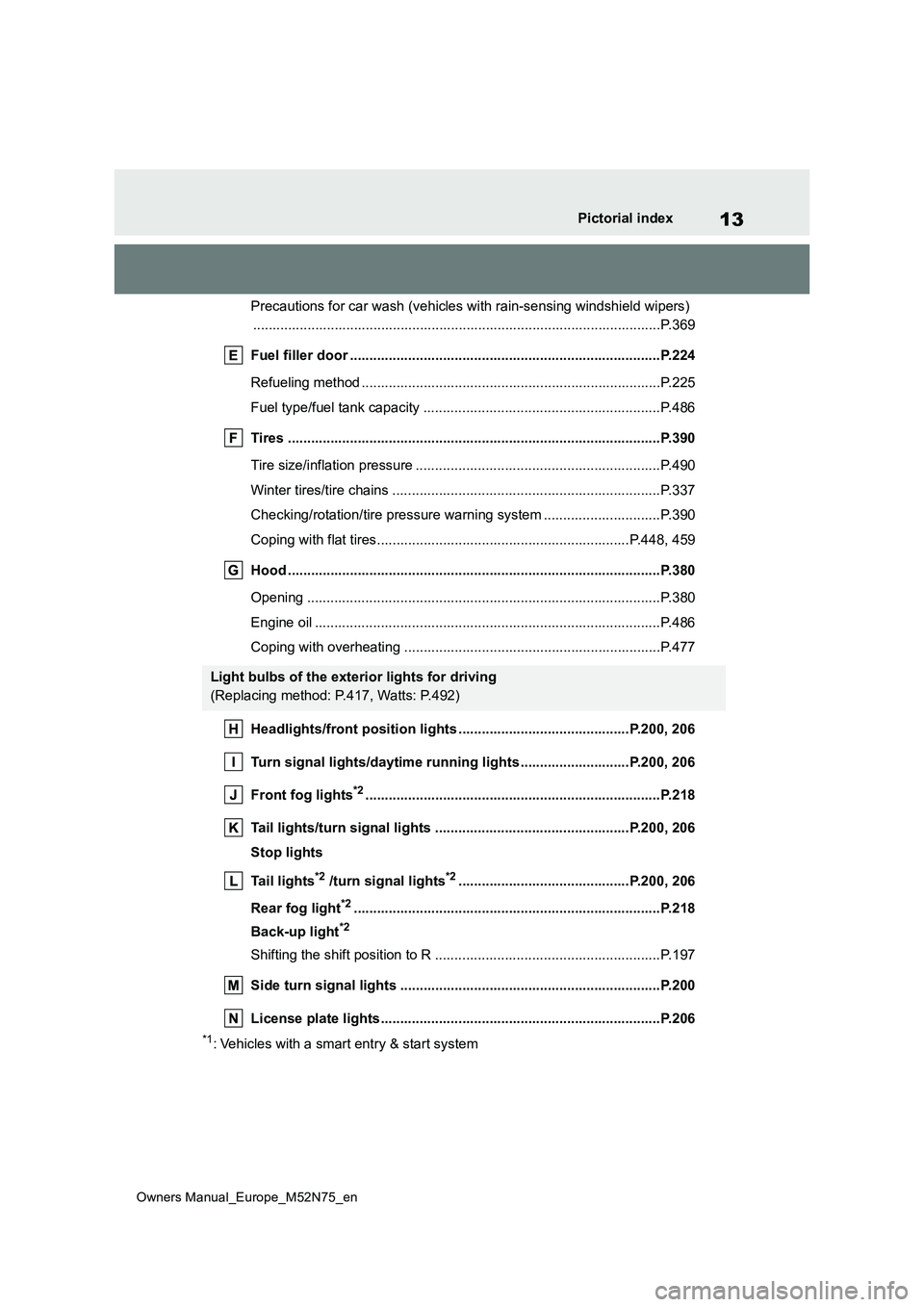
13
Owners Manual_Europe_M52N75_en
Pictorial index
Precautions for car wash (vehicles with rain-sensing windshield wipers)
............................................................... ..........................................P.369
Fuel filler door ............................................... .................................P.224
Refueling method ............................................... ..............................P.225
Fuel type/fuel tank capacity ................................... ..........................P.486
Tires .......................................................... ......................................P.390
Tire size/inflation pressure ................................... ............................P.490
Winter tires/tire chains ....................................... ..............................P.337
Checking/rotation/tire pressure warning system ................. .............P.390
Coping with flat tires......................................... ........................P.448, 459
Hood ........................................................... .....................................P.380
Opening ........................................................ ...................................P.380
Engine oil ..................................................... ....................................P.486
Coping with overheating ........................................ ..........................P.477
Headlights/front position lights ............................... .............P.200, 206
Turn signal lights/daytime running lights ...................... ......P.200, 206
Front fog lights*2............................................................... .............P.218
Tail lights/turn signal lights ................................. .................P.200, 206
Stop lights
Tail lights*2 /turn signal lights*2............................................P.200, 206
Rear fog light*2............................................................... ................P.218
Back-up light*2
Shifting the shift position to R ............................... ...........................P.197
Side turn signal lights ........................................ ...........................P.200
License plate lights........................................... .............................P.206
*1: Vehicles with a smart entry & start system
Light bulbs of the exterior lights for driving
(Replacing method: P.417, Watts: P.492)
Page 42 of 698
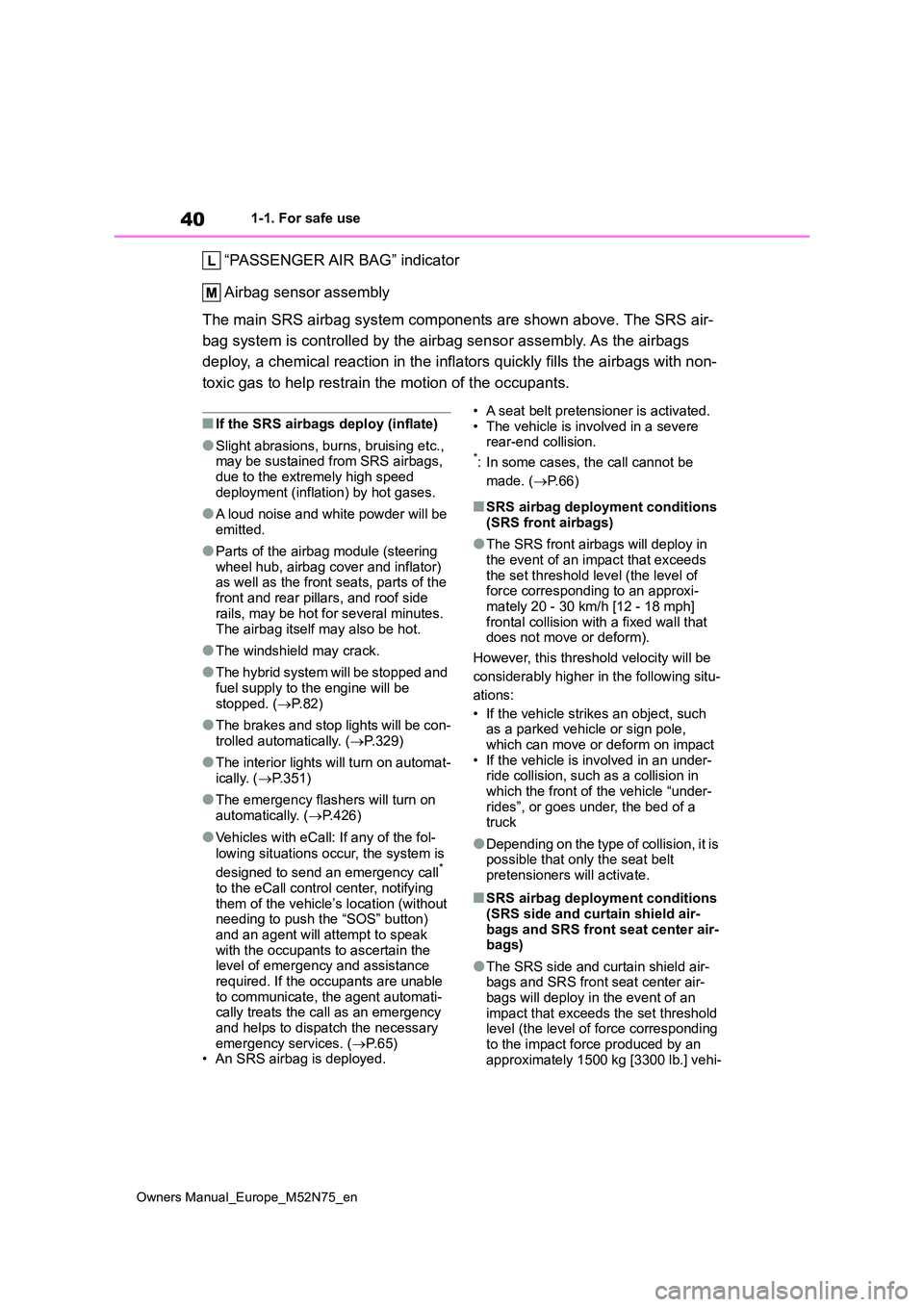
40
Owners Manual_Europe_M52N75_en
1-1. For safe use
“PASSENGER AIR BAG” indicator
Airbag sensor assembly
The main SRS airbag system components are shown above. The SRS air-
bag system is controlled by the airbag sensor assembly. As the airbags
deploy, a chemical reaction in the inflators quickly fills the airbags with non-
toxic gas to help restrain the motion of the occupants.
■If the SRS airbags deploy (inflate)
●Slight abrasions, burns, bruising etc., may be sustained from SRS airbags,
due to the extremely high speed deployment (inflation) by hot gases.
●A loud noise and white powder will be emitted.
●Parts of the airbag module (steering wheel hub, airbag cover and inflator) as well as the front seats, parts of the
front and rear pillars, and roof side rails, may be hot for several minutes.
The airbag itself may also be hot.
●The windshield may crack.
●The hybrid system will be stopped and fuel supply to the engine will be
stopped. ( P.82)
●The brakes and stop lights will be con-
trolled automatically. ( P.329)
●The interior lights will turn on automat-
ically. ( P.351)
●The emergency flashers will turn on
automatically. ( P.426)
●Vehicles with eCall: If any of the fol-
lowing situations occur, the system is
designed to send an emergency call* to the eCall control center, notifying
them of the vehicle’s location (without needing to push the “SOS” button) and an agent will attempt to speak
with the occupants to ascertain the level of emergency and assistance required. If the occupants are unable
to communicate, the agent automati- cally treats the call as an emergency and helps to dispatch the necessary
emergency services. ( P.65) • An SRS airbag is deployed.
• A seat belt pretensioner is activated. • The vehicle is involved in a severe rear-end collision.*: In some cases, the call cannot be
made. ( P. 6 6 )
■SRS airbag deployment conditions
(SRS front airbags)
●The SRS front airbags will deploy in
the event of an impact that exceeds the set threshold level (the level of force corresponding to an approxi-
mately 20 - 30 km/h [12 - 18 mph] frontal collision with a fixed wall that does not move or deform).
However, this threshold velocity will be
considerably higher in the following situ-
ations:
• If the vehicle strikes an object, such as a parked vehicle or sign pole, which can move or deform on impact
• If the vehicle is involved in an under- ride collision, such as a collision in which the front of the vehicle “under-
rides”, or goes under, the bed of a truck
●Depending on the type of collision, it is possible that only the seat belt pretensioners will activate.
■SRS airbag deployment conditions
(SRS side and curtain shield air- bags and SRS front seat center air-bags)
●The SRS side and curtain shield air-bags and SRS front seat center air-
bags will deploy in the event of an impact that exceeds the set threshold level (the level of force corresponding
to the impact force produced by an approximately 1500 kg [3300 lb.] vehi-
Page 77 of 698

75
1
Owners Manual_Europe_M52N75_en
1-4. Hybrid system
For safety and security
1-4.Hybrid sy stem
■System components
The illustration is an example for explanation and may differ from the actual item.
Gasoline engine
Front electric motor (traction motor)
Rear electric motor (traction motor)*
*: AWD models only
■When stopped/during start off
The gasoline engine stops* when
the vehicle is stopped. During start
off, the electric m otor (traction
Hybrid system features
Your vehicle is a hybrid electric vehicle. It has characteristics differ-
ent from conventional vehicles. Be sure you are closely familia r with
the characteristics of your vehicle, and operate it with care.
The hybrid system combines the use of a gasoline engine and an
electric motor (traction motor) according to driving conditions,
improving fuel efficiency and reducing exhaust emissions.
System components
Page 78 of 698
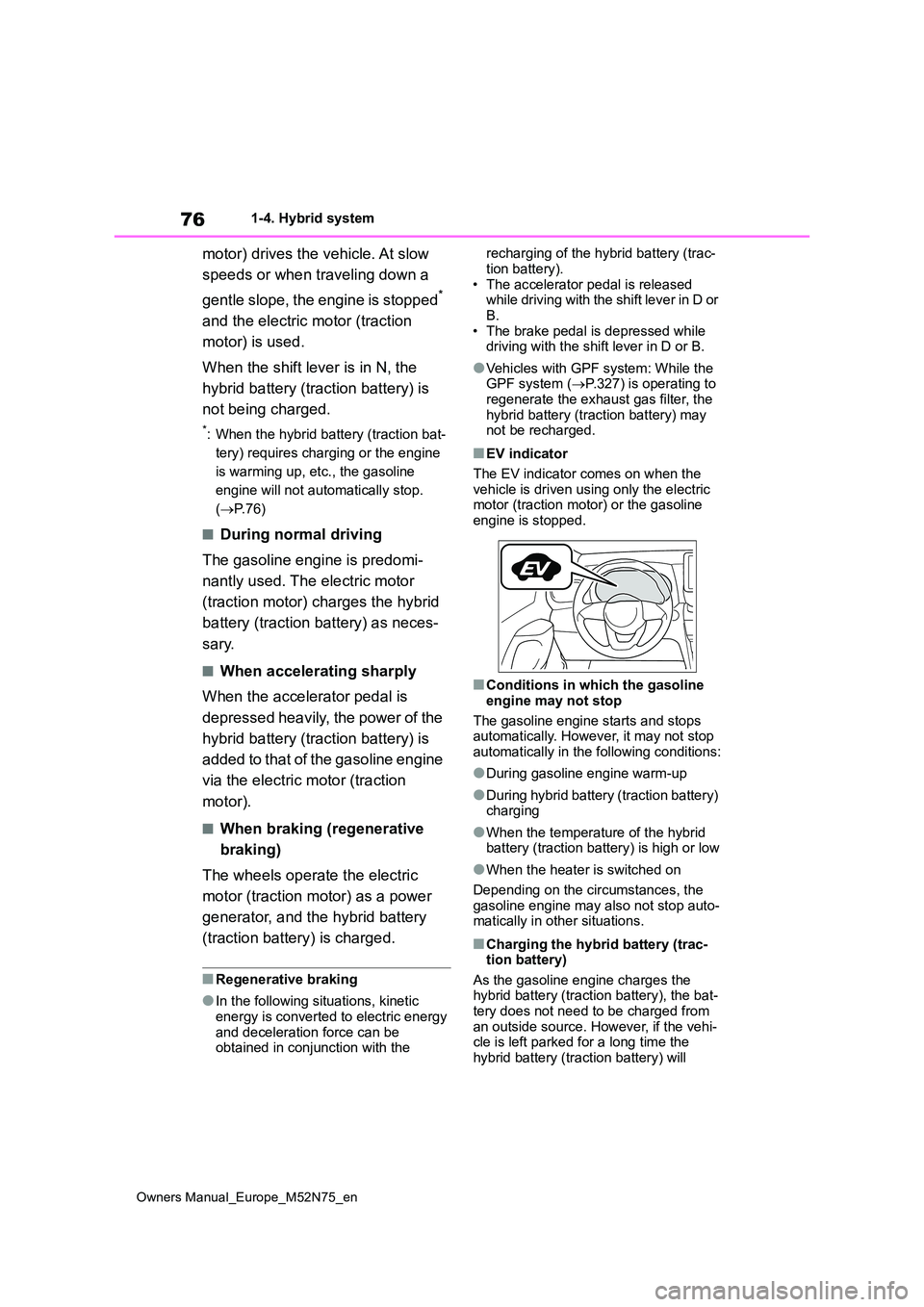
76
Owners Manual_Europe_M52N75_en
1-4. Hybrid system
motor) drives the vehicle. At slow
speeds or when traveling down a
gentle slope, the engine is stopped*
and the electric motor (traction
motor) is used.
When the shift lever is in N, the
hybrid battery (traction battery) is
not being charged.
*: When the hybrid battery (traction bat-
tery) requires charging or the engine
is warming up, etc., the gasoline
engine will not automatically stop.
( P. 7 6 )
■During normal driving
The gasoline engine is predomi-
nantly used. The electric motor
(traction motor) charges the hybrid
battery (traction battery) as neces-
sary.
■When accelerating sharply
When the accelerator pedal is
depressed heavily, the power of the
hybrid battery (traction battery) is
added to that of the gasoline engine
via the electric motor (traction
motor).
■When braking (regenerative
braking)
The wheels operate the electric
motor (traction motor) as a power
generator, and the hybrid battery
(traction battery) is charged.
■Regenerative braking
●In the following situations, kinetic
energy is converted to electric energy and deceleration force can be obtained in conjunction with the
recharging of the hybrid battery (trac-
tion battery). • The accelerator pedal is released while driving with the shift lever in D or
B. • The brake pedal is depressed while driving with the shift lever in D or B.
●Vehicles with GPF system: While the GPF system ( P.327) is operating to
regenerate the exhaust gas filter, the hybrid battery (traction battery) may not be recharged.
■EV indicator
The EV indicator comes on when the vehicle is driven using only the electric motor (traction motor) or the gasoline
engine is stopped.
■Conditions in which the gasoline
engine may not stop
The gasoline engine starts and stops automatically. However, it may not stop
automatically in the following conditions:
●During gasoline engine warm-up
●During hybrid battery (traction battery) charging
●When the temperature of the hybrid battery (traction battery) is high or low
●When the heater is switched on
Depending on the circumstances, the
gasoline engine may also not stop auto- matically in other situations.
■Charging the hybrid battery (trac-tion battery)
As the gasoline engine charges the hybrid battery (traction battery), the bat-tery does not need to be charged from
an outside source. However, if the vehi- cle is left parked for a long time the hybrid battery (traction battery) will
Page 79 of 698
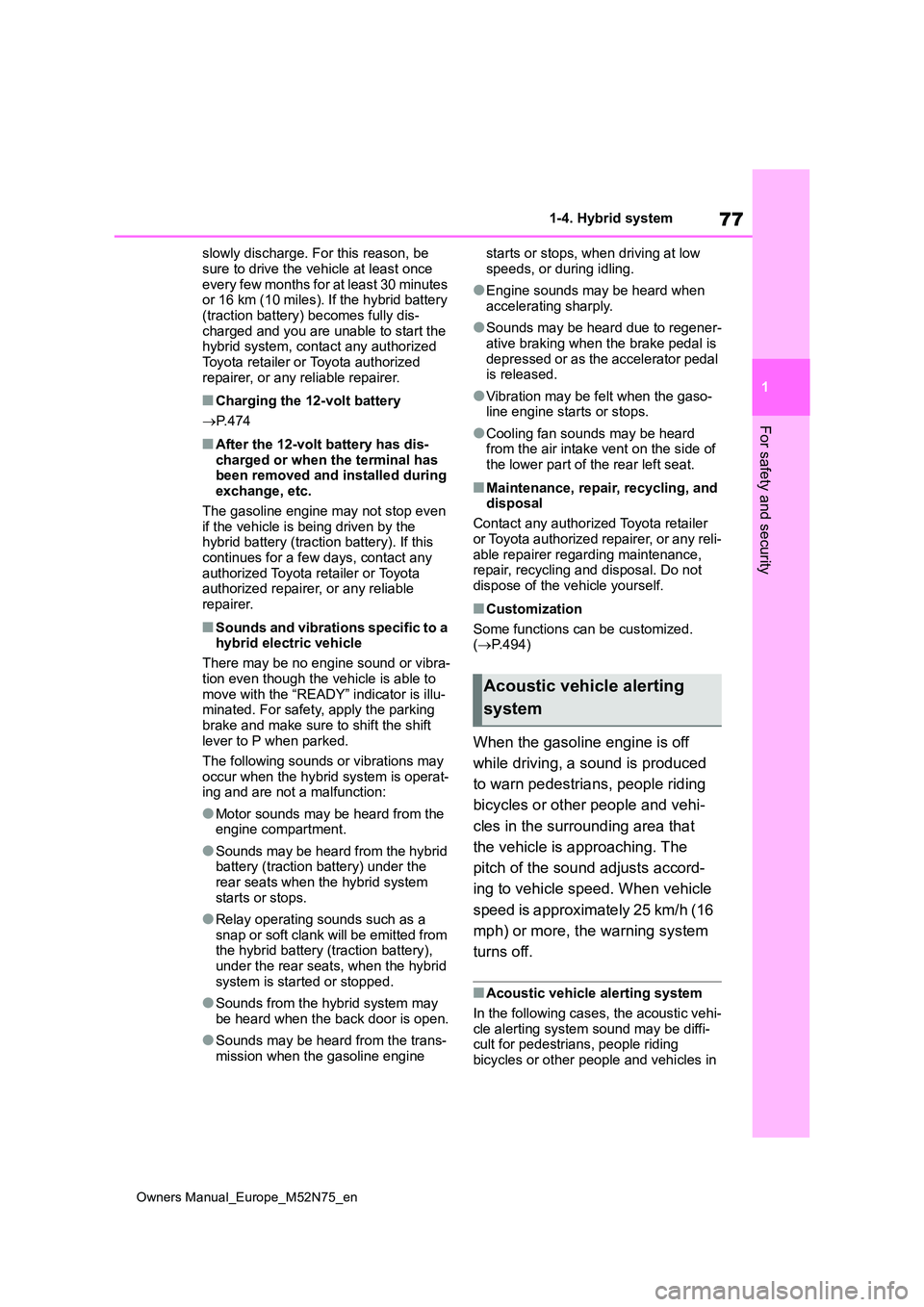
77
1
Owners Manual_Europe_M52N75_en
1-4. Hybrid system
For safety and security
slowly discharge. For this reason, be
sure to drive the vehicle at least once every few months for at least 30 minutes or 16 km (10 miles). If the hybrid battery
(traction battery) becomes fully dis- charged and you are unable to start the hybrid system, contact any authorized
Toyota retailer or Toyota authorized repairer, or any reliable repairer.
■Charging the 12-volt battery
P. 4 7 4
■After the 12-volt battery has dis-
charged or when the terminal has been removed and installed during exchange, etc.
The gasoline engine may not stop even if the vehicle is being driven by the hybrid battery (traction battery). If this
continues for a few days, contact any authorized Toyota retailer or Toyota authorized repairer, or any reliable
repairer.
■Sounds and vibrations specific to a hybrid electric vehicle
There may be no engine sound or vibra-
tion even though the vehicle is able to move with the “READY” indicator is illu-minated. For safety, apply the parking
brake and make sure to shift the shift lever to P when parked.
The following sounds or vibrations may
occur when the hybrid system is operat- ing and are not a malfunction:
●Motor sounds may be heard from the engine compartment.
●Sounds may be heard from the hybrid battery (traction battery) under the rear seats when the hybrid system
starts or stops.
●Relay operating sounds such as a
snap or soft clank will be emitted from the hybrid battery (traction battery), under the rear seats, when the hybrid
system is started or stopped.
●Sounds from the hybrid system may
be heard when the back door is open.
●Sounds may be heard from the trans-
mission when the gasoline engine
starts or stops, when driving at low
speeds, or during idling.
●Engine sounds may be heard when
accelerating sharply.
●Sounds may be heard due to regener-
ative braking when the brake pedal is depressed or as the accelerator pedal is released.
●Vibration may be felt when the gaso-line engine starts or stops.
●Cooling fan sounds may be heard from the air intake vent on the side of
the lower part of the rear left seat.
■Maintenance, repair, recycling, and disposal
Contact any authorized Toyota retailer
or Toyota authorized repairer, or any reli- able repairer regarding maintenance, repair, recycling and disposal. Do not
dispose of the vehicle yourself.
■Customization
Some functions can be customized. ( P.494)
When the gasoline engine is off
while driving, a sound is produced
to warn pedestrians, people riding
bicycles or other people and vehi-
cles in the surrounding area that
the vehicle is approaching. The
pitch of the sound adjusts accord-
ing to vehicle speed. When vehicle
speed is approximately 25 km/h (16
mph) or more, the warning system
turns off.
■Acoustic vehicle alerting system
In the following cases, the acoustic vehi- cle alerting system sound may be diffi-cult for pedestrians, people riding
bicycles or other people and vehicles in
Acoustic vehicle alerting
system
Page 93 of 698

91
2
Owners Manual_Europe_M52N75_en
2-1. Instrument cluster
Vehicle status information and indicators
Vehicles with 7-inch display (when digital speedometer is displayed)
Warning lights inform the driver of
malfunctions in the indicated vehi-
cle’s systems.
Warning lights
(Red)
Brake system warning light*1
( P.435)
(Yellow)
Brake system warning light*1
( P.435)
High coolant temperature
warning light*2 ( P.435)
Hybrid system overheat
warning light*2 ( P.436)
Charging system warning
light*2 ( P.436)
Low engine oil pressure
warning light*2 ( P.436)
Malfunction indicator lamp*1,
3 ( P.436)
SRS warning light*1
( P.437)
ABS warning light*1
( P.437)
Inappropriate pedal opera-
tion warning light*2 ( P. 4 3 7 )
(Red)
Electric power steering sys-
tem warning light*1, 3
( P.438)
(Yellow)
Electric power steering sys-
tem warning light*1, 3
( P.438)
Low fuel level warning light
( P.438)
Driver’s and front passen-
ger’s seat belt reminder light
( P.438)
Rear passengers’ seat
belt reminder lights*2
( P.438)
Tire pressure warning light*1,
3 ( P.439)
(Orange)
LTA i n d i c a t o r*2 (if equipped)
( P.439)
(Flashes)
Toyota parking assist-sensor
OFF indicator*1, 3 (if
equipped) ( P.440)
Page 97 of 698
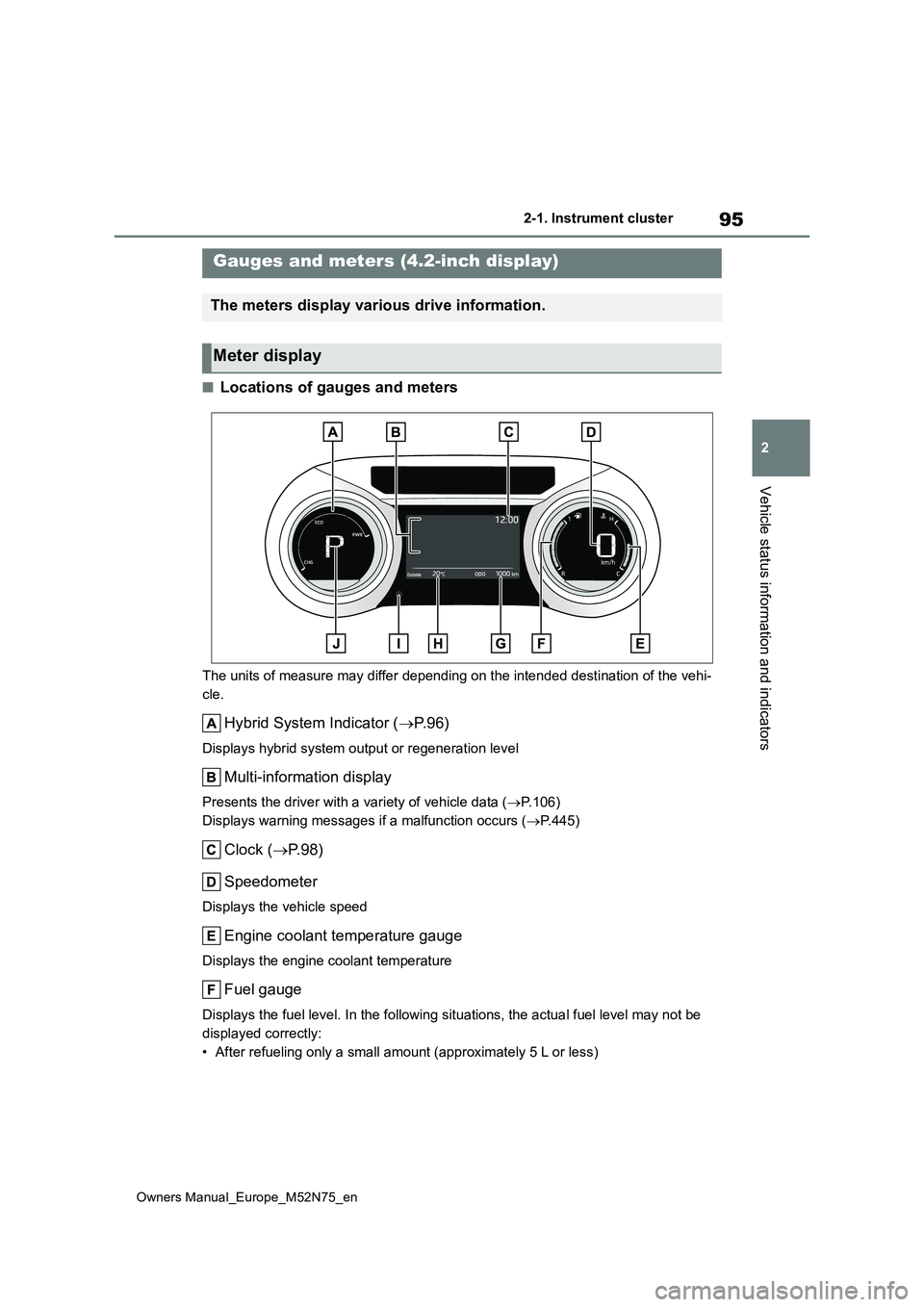
95
2
Owners Manual_Europe_M52N75_en
2-1. Instrument cluster
Vehicle status information and indicators
■Locations of gauges and meters
The units of measure may differ depending on the intended destination of the vehi-
cle.
Hybrid System Indicator ( P. 9 6 )
Displays hybrid system output or regeneration level
Multi-information display
Presents the driver with a variety of vehicle data (P.106)
Displays warning messages if a malfunction occurs ( P.445)
Clock (P.98)
Speedometer
Displays the vehicle speed
Engine coolant temperature gauge
Displays the engine coolant temperature
Fuel gauge
Displays the fuel level. In the following situations, the actua l fuel level may not be
displayed correctly:
• After refueling only a small amount (approximately 5 L or less )
Gauges and meters (4.2-inch display)
The meters display various drive information.
Meter display
Page 98 of 698

96
Owners Manual_Europe_M52N75_en
2-1. Instrument cluster
• When stopped on a hill or other slope
• When driving on a slope or around a curve
Odometer and trip meter display ( P. 9 7 )
Outside temperature
Displays the outside temperature within the range of -40°C (-40 °F) to 60°C (140°F)
Display change button (P. 9 7 )
Shift position indicator ( P.197)
■Engine speed
On hybrid electric vehicles, engine speed is precisely controlled in order to help improve fuel efficiency and reduce
exhaust emissions, etc. There are times when the engine speed that is displayed may differ even when
vehicle operation and driving conditions are the same.
■Hybrid System Indicator
Charge area
Shows regeneration* status.
Regenerated energy will be used to
charge the hybrid battery (traction bat-
tery).
Hybrid Eco area
Shows that gasoline engine power is not
being used very often.
The gasoline engine will automatically
stop and restart under various condi-
tions.
Eco area
Shows that the vehicle is being driven in
an Eco-friendly manner.
By keeping the indicator needle within
Eco area, more Eco-friendly driving can
be achieved.
Power area
Shows that an Eco-friendly driving range
is being exceeded (during full power
driving, etc.)
*: When used in this manual, regenera-
tion refers to the conversion of energy
created by the movement of the vehi-
cle into electrical energy.
In the following situation, the Hybrid System Indicator does not operate.
●Hybrid System Indicator is not illumi-nated.
●The shift position is in a range other than D or B.
■Outside temperature display
●In the following situations, the correct outside temperature may not be dis-played, or the display may take longer
than normal to change: • When stopped, or driving at low speeds (less than 25 km/h [16 mph])